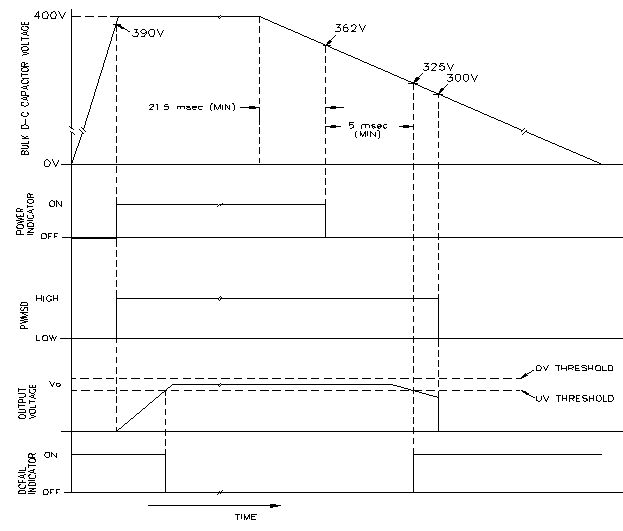Visual indication is provided via the four LED indicators located on the front panel. Signal indication is obtained via four sets of Form C dry relay contacts accessed via the I/O connector; all three contacts are provided to the user, permitting the selection of either normally-open (NO), normally-closed (NC) or both for any application.
The definition of "normal" in this instance refers to the status of the contacts when the HSP is powered and operating normally (no fault); status flag outputs remain valid even when source power is removed. These relay contacts are SELV and are isolated from each other and from the output by 100V d-c to permit flexibility in application. A description of the function of each status signal follows. The Table below indicates the condition of status flags and indicators for normal, fault, and no power conditions.
STATUS INDICATORS AND FLAGS
| Condition | Signal/Indicator | Status | ||
| Normal (1) | Fault Detected |
No Power Applied |
||
|
Source Power Status |
POWER indicator | ON (Green) | OFF | ON |
| Source power status NC | Closed (2) | Open (2) | Open (2) | |
| Source power status NO | Open (2) | Closed (2) | Closed (2) | |
|
Output Status |
DC FAIL indicator | OFF | ON (Red) | OFF |
| Output status NC | Closed (2) | Open (2) | Open (2) | |
| Output status NO | Open (2) | Closed (2) | Closed (2) | |
|
Fan Status (3) |
FANFAIL indicator | OFF | ON (Red) | OFF |
| Fan status NC | Closed (2) | Open (2) | Closed (2) | |
| Fan status NO | Open (2) | Closed (2) | Open (2) | |
|
Overtemperature Status (3) |
OVERTEMP indicator | OFF | ON (Amber) | OFF |
| OVERTEMP status NC | Closed (2) | Open (2) | Closed (2) | |
| OVERTEMP status NO | Open (2) | Closed (2) | Open (2) | |
| (1) | Normal is defined as the HSP powered and operating with no faults (source power within specifications, output power within rated limits, fan operating, and no overtemperature condition sensed. |
| (2) | Closed and Open are referenced to the associated status common termination. |
| (3) | Upon initial turn-on, fan and overtemperature status lines will be in a "Normal" condition unless a fault condition is sensed. |
